Lower Back Pain From Deadlift
Igor Gershengorin
By Yana Blinova, MS, Inventor of Pelvic Clock® Exercise Device, Former Olympic Coach.
Deadlift is one of the most effective weightlifting exercises.
A Traditional Deadlift targets the glutes, quads and QL muscles, and starts with bent knees. The barbell is lifted off the ground to an upright standing position. It sounds simple, but when done incorrectly a Deadlift can cause lower back pain.
Poor postures with a Rounded back, Arched back, or Rotated Pelvis lead to back ache after Deadlift and could also lead to serious injuries.
The treatment of lower back pain after deadlifting depends on the type of injury.
A single mistake in Deadlift body mechanics can result in a lumbar muscle strain.
Lower Back Muscle Strain After Deadlift
Recovering from a lower back muscle strain takes more than two weeks.
Ice the injured area, rest for a few days, and consult with your doctor if the pain doesn’t subside.
Weightlifters with mild muscle strains can continue with a modified low impact training. A complete interruption of training is required only in the most severe cases.
The Key to a successful recovery is in small details.
After the injury the healthy side of the lower back compensates for the injured side. This is why a simple muscle strain can lead to the following misalignments of the pelvis:
A Neutral Spine position is essential to reduce the risk of lower back injuries caused by deadlifting.
As injured muscles heals, they form scar tissue. Less flexible than a healthy tissue, scar tissue limits the range of motion.
Pelvic Clock® Stretches helps to restore muscle elasticity and flexibility of the lumbar spine.
Chronic Lower Back Pain After Deadlift
Repeating the same mistakes in deadlift body mechanics over and over again, might cause chronic lower back conditions such as:
Avoid a Romanian Deadlift when healing from a lower back injury.
A Hamstring Stretch during a Straight Leg Deadlift might trigger sciatic nerve inflammation and result in long lasting Sciatica.
Deadlift with Scoliosis
Barbell Deadlifting is not recommended for people diagnosed with Scoliosis.
During a Bilateral Barbell Deadlift, the dominant side takes on more of the workload.
Unilateral Deadlifts are a better option as they strengthen the weaker side of the body.
A single arm kettlebell “Suitcase Deadlift” targets the QL Quadratus Lumborum muscles.
A single leg kettlebell Deadlift helps to strengthen the gluteus medius, ankle, gluteus medius and core muscles.
Together with Pelvic Clock® Exercises for Lumbar Scoliosis, Unilateral Deadlifts help to gradually straighten a curved lumbar spine.
Why use the Pelvic Clock®?
The Pelvic Clock® is a portable exercise tool developed by a former Olympic coach to make lower back exercises more effective.
The Pelvic Clock® Workout includes pain relieving stretches and core stability exercises suitable for different stages of lower back rehabilitation.
It helps to stretch the tight side of the pelvis and strengthen the weak side of the core.
The right selection of Pelvic Clock® Stretches and Core Stability exercises will depend on specific conditions.
Please check the full list here. At the bottom of each page you’ll find a free PDF with recommended exercises and stretches.
Or you can get started with our 4-week exercise program and watch our videos.






